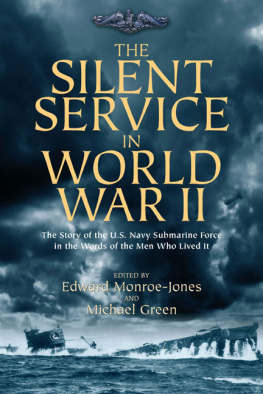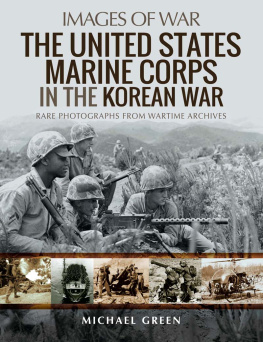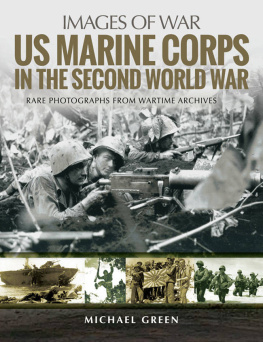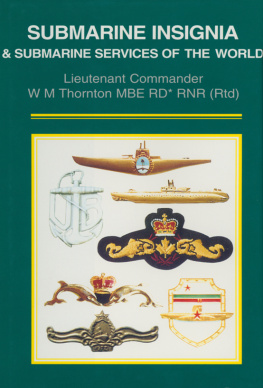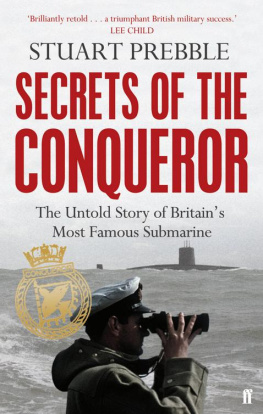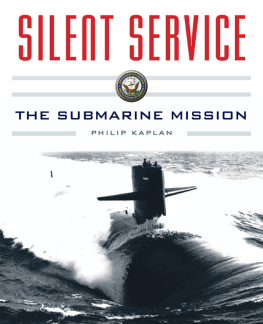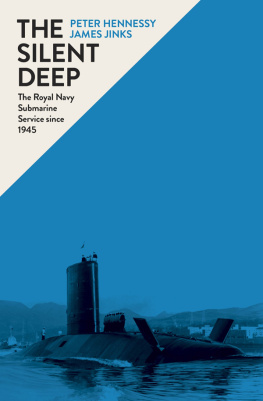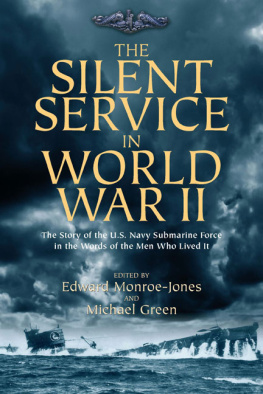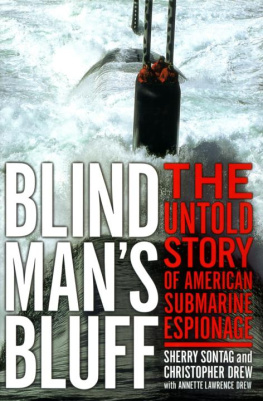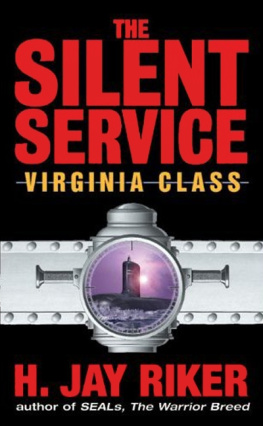Michael Green - The Silent Service in World War II: The Story of the U.S. Navy Submarine Force in the Words of the Men Who Lived It
Here you can read online Michael Green - The Silent Service in World War II: The Story of the U.S. Navy Submarine Force in the Words of the Men Who Lived It full text of the book (entire story) in english for free. Download pdf and epub, get meaning, cover and reviews about this ebook. year: 2012, publisher: Casemate, genre: Non-fiction. Description of the work, (preface) as well as reviews are available. Best literature library LitArk.com created for fans of good reading and offers a wide selection of genres:
Romance novel
Science fiction
Adventure
Detective
Science
History
Home and family
Prose
Art
Politics
Computer
Non-fiction
Religion
Business
Children
Humor
Choose a favorite category and find really read worthwhile books. Enjoy immersion in the world of imagination, feel the emotions of the characters or learn something new for yourself, make an fascinating discovery.
- Book:The Silent Service in World War II: The Story of the U.S. Navy Submarine Force in the Words of the Men Who Lived It
- Author:
- Publisher:Casemate
- Genre:
- Year:2012
- Rating:4 / 5
- Favourites:Add to favourites
- Your mark:
- 80
- 1
- 2
- 3
- 4
- 5
The Silent Service in World War II: The Story of the U.S. Navy Submarine Force in the Words of the Men Who Lived It: summary, description and annotation
We offer to read an annotation, description, summary or preface (depends on what the author of the book "The Silent Service in World War II: The Story of the U.S. Navy Submarine Force in the Words of the Men Who Lived It" wrote himself). If you haven't found the necessary information about the book — write in the comments, we will try to find it.
The Silent Service in World War II: The Story of the U.S. Navy Submarine Force in the Words of the Men Who Lived It — read online for free the complete book (whole text) full work
Below is the text of the book, divided by pages. System saving the place of the last page read, allows you to conveniently read the book "The Silent Service in World War II: The Story of the U.S. Navy Submarine Force in the Words of the Men Who Lived It" online for free, without having to search again every time where you left off. Put a bookmark, and you can go to the page where you finished reading at any time.
Font size:
Interval:
Bookmark:


Published in the United States of America and Great Britain in 2012 by
CASEMATE PUBLISHERS
908 Darby Road, Havertown, PA 19083
and
10 Hythe Bridge Street, Oxford, OX1 2EW
Copyright 2012 Edward Monroe Jones and Michael Green
ISBN 978-1-61200-125-8
Digital Edition: ISBN 978-1-61200-137-1
Cataloging-in-publication data is available from the Library of Congress and
the British Library.
All rights reserved. No part of this book may be reproduced or transmitted in any form or
by any means, electronic or mechanical including photocopying, recording or by any infor
mation storage and retrieval system, without permission from the Publisher in writing.
The Battle of the Philippine Sea 2012 by Ernest J. Zellmer, used by permission.
Many of the stories in this book were originally published by Polaris Magazine and Submarine
Journal. Others were previously published in the book Steep Angles, Deep Dives. These stories
are used by permission of their respective copyright holders.
10 9 8 7 6 5 4 3 2 1
Printed and bound in the United States of America.
For a complete list of Casemate titles please contact:
CASEMATE PUBLISHERS (US)
Telephone (610) 853-9131, Fax (610) 853-9146
E-mail:
CASEMATE PUBLISHERS (UK)
Telephone (01865) 241249, Fax (01865) 794449
E-mail:

PART THREE: LATE WAR STORIES (19441945)
The editors wish to thank the many World War Two veteran submariners who have contributed their experiences to the sources from which this anthology was compiled. Those sources include the following:
Submarine Veterans of World War II, its Board of Directors and its 2008 President, Mr. Clarence Scott.
The editors of Polaris Magazine, a publication of Submarine Veterans of World War II.
The United States Submarine League, its quarterly journal, The Submarine Review and its editor, Captain James Hay, USN (ret.).
The National Museum of the Pacific War, Center for Pacific War Studies and its research staff.
Submarine Research Center and the many veteran submariners contributing their experiences directly to the construction of this anthology.

Those submariners contributing to this anthology of Second World War experiences have used phrases and words that were peculiar to the parlance of submarine technology and procedure. To help the reader gain an understanding of the language usage a few of the more common expressions and abbreviations are listed below;
The 1MC is the general announcing system made up of speakers in all compartments with microphones in control, conning tower and bridge. It is used to give information to all hands in the boat at the same time.
The 7MC announcing system is a series of microphones/loud speakers in the torpedo rooms, maneuvering room, control room, conning tower, and bridge. It is used when maneuvering the ship and when at battle stations. It is used to quickly convey information without disturbing off-watch crew members.
Answering Bells were used to signal speed changes. A fleet-type submarines bells could signal stop, ahead one-third, ahead two-thirds, ahead standard, ahead full, and ahead flank. There were also backing bells: back one-third, back two-thirds, back full, and back emergency. Since the boat had twin screws a maneuvering bell might refer to the port screw, starboard screw or all, meaning both screws. For example a tight turn could be made by dragging the inboard screw. The order might be All stop. Starboard ahead standard, port back two-thirds. When the turn is completed the ordered bell might be All ahead full.
Approach is synonymous with torpedo attack. It is the process of bringing the submarine into a position which will allow it to deliver torpedoes with maximum chance of hitting the target. Most World War II approaches were conducted on the surface at night. Some were conducted during the day when weather made detection less likely. Submerged approaches made using the periscope were handicapped by slow maneuvering speeds.
Christie, Admiral Ralph was commander of the submarines operating out of Fremantle before being relieved by Admiral Fife.
Conn, conn., or conning refers to the person designated by the captain to run the ship in his absence. When on the surface the ships safety was in the hands of the conning officer, when submerged the conning officer was stationed in the conning tower. He gave orders for course, speed, and depth, and informed the captain when had concerns for the safety of the ship. Conn or conn. also refers to the conning tower as the place from which the boat was conned when it was submerged and where attacks were conducted.
Cubicle referred to the maneuvering room enclosure that housed the dangerous high-voltage switching equipment for the main propulsion plant.
Dinky was the auxiliary diesel engine. A fleet-type submarine had four propulsion engines and a small auxiliary engine for charging batteries and powering the housekeeping load. It sometimes was called upon to propel the submarine when all four main engines were out of commission.
DR or Dead Reckoning is the term that refers to the simple navigational process of using course and speed to determine a submarines location.
Exec, exec., or XO refers to the executive officer who is the number two person in charge of the boat. His duties include all the paperwork of the submarine as well as being navigator and operations officer when another officer has not been so designated. He acts as assistant to the captain during battle stations and is in the conning tower next to him giving advice on an approach to a target.
The Gangway or Brow was the short platform which stretched from boat to boat or boat to pier when it was tied up alongside.
Gangway Watch or Topside Watch refers to the enlisted person assigned to protect the ships safety when tied up in port. His station was on the quarter deck, except that submarines really had no quarterdeck, so he simply stationed himself next to the brow or gangway where he could keep an eye on people coming aboard the submarine.
Green Board referred to the green hull opening lights on the Christmas Tree hydraulic panel which meant that all openings were shut and the boat was safe to submerge. It was usually combined with, Pressure in the boat, when a small amount of compressed air was internally released. If the barometer needle remained constant the boat was airtight and therefore watertight.
Fife, Admiral John was commander of the submarines operating out of Brisbane and later out of Fremantle and Subic Bay.
Lockwood, Admiral Charles was Commander Submarines Pacific (ComSubPac) during the war. His headquarters was at Pearl Harbor.
Maneuvering Watch refers to the stations manned by the crew when the ship is being conned in close waters such as a harbor, alongside a pier, in a nest (a group of submarines tied up sided-by-side, typically next to a submarine tender), or in a river. Battle stations during the war referred to either making a torpedo run or using the deck weapons. The former was referred to as, Battle stationstorpedo and the later as Battle stationsgun action.
Font size:
Interval:
Bookmark:
Similar books «The Silent Service in World War II: The Story of the U.S. Navy Submarine Force in the Words of the Men Who Lived It»
Look at similar books to The Silent Service in World War II: The Story of the U.S. Navy Submarine Force in the Words of the Men Who Lived It. We have selected literature similar in name and meaning in the hope of providing readers with more options to find new, interesting, not yet read works.
Discussion, reviews of the book The Silent Service in World War II: The Story of the U.S. Navy Submarine Force in the Words of the Men Who Lived It and just readers' own opinions. Leave your comments, write what you think about the work, its meaning or the main characters. Specify what exactly you liked and what you didn't like, and why you think so.

